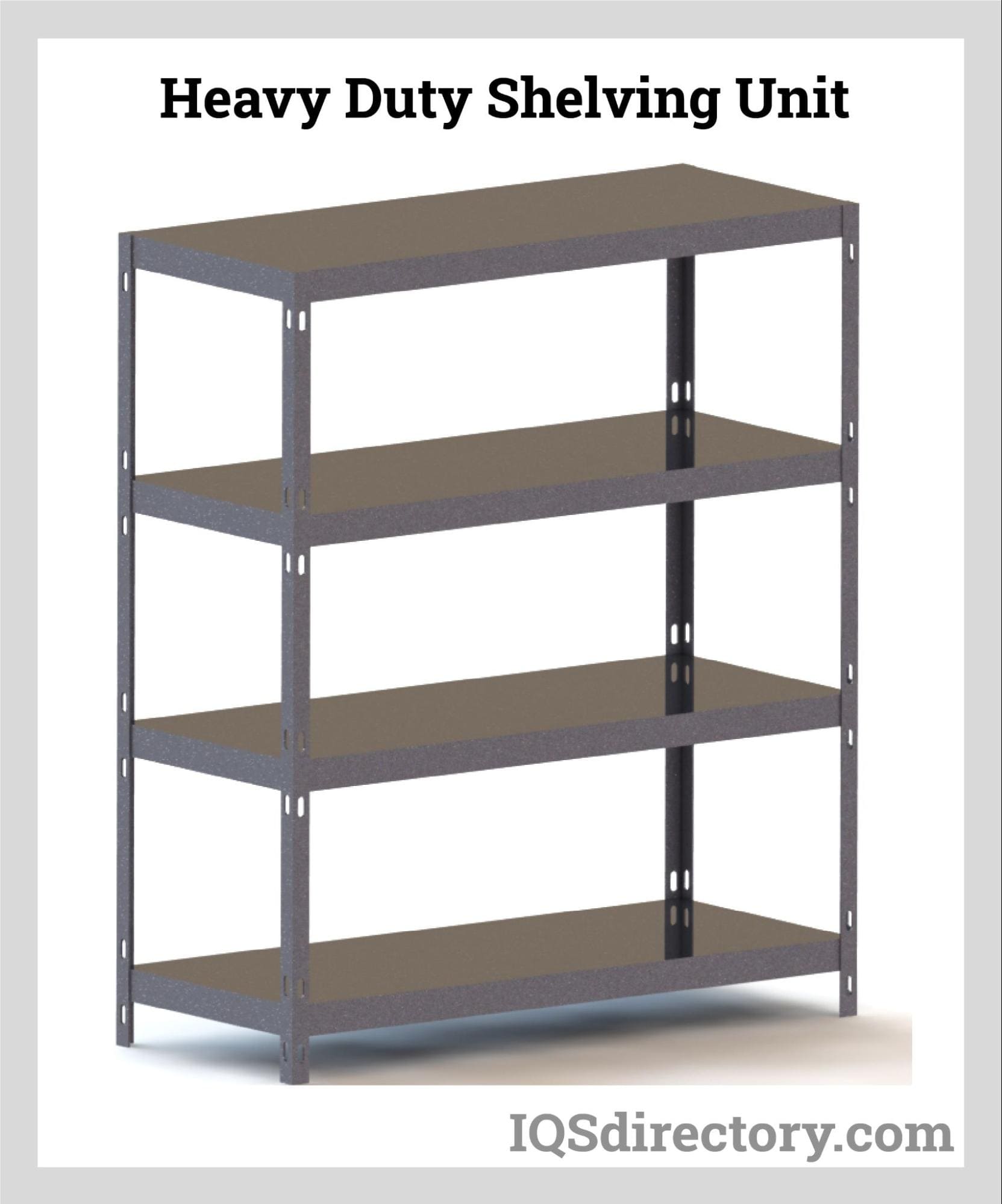Heavy-Duty Shelving
Large, heavy loads exceeding standard shelf units’ maximum weight capabilities require heavy-duty shelving. Heavy-duty shelving is used in warehouses to store bulky pallets or huge items. For big freight, these units offer the necessary support.
Heavy-Duty Shelving Design Factors
A variety of designs are offered for heavy-duty shelving systems. The dimensions of the shelves and the materials used to make them are the two factors that distinguish these designs most. Dimensions include weight capacity in addition to height, length, and depth. Heavy-duty shelving is fixed to the ground and can have several back supports below each shelf, unlike wall shelving, which can only have a specific amount of support and, consequently, can only hold a given amount of weight.

Materials for Heavy-Duty Shelving
Hard metals like steel or stainless steel are typically used to produce heavy-duty shelves due to their strength and durability. Treated wood can also be used to make heavy-duty shelving depending on the purpose. However, wood shelving systems frequently have some form of metal frame. Numerous stains and treatments can also provide the wood with added protection from various items. If desired, shelving units can be manufactured out of chemically resistant materials, designed to be transportable, or created to be fireproof.

Applications of Heavy Duty Shelving
Industrial supply or construction-focused stores, warehouses, garages, and manufacturing facilities are the sectors that use heavy-duty shelf systems most frequently. Industrial warehouses store a wide range of commodities, frequently doubling as shipping ports for suppliers and manufacturers. Loading docks are a regular sight in warehouses where cargo is frequently loaded and unloaded.
Although most warehouses are enormous, an organizing system must be implemented for products to be correctly stacked and conveniently located. Heavy strength shelving makes it possible to utilize every square foot of a warehouse while keeping everyone working inside safe. Heavy-duty shelving is also used in garages to store bulky tools and automobile parts safely and conveniently. Because they frequently resemble industrial warehouses and sell heavy things, hardware stores also need strong-duty shelving.
Types of Heavy-Duty Shelves
Industrial Steel Shelves
Industrial steel shelving is a reliable and adaptable storage solution that can accommodate a variety of bulky and heavy items, such as steel castings, automobile parts, and power equipment. It is a well-liked solution for factories and auto repair shops. Steel shelving is adjustable and can be utilized in both open and closed layouts. In addition, it is movable and may be equipped with more boxes, dividers, and storage bins. Since car equipment can range in size from tiny pieces to large engine components, it provides a great storage option for auto shop shelves.
Bolt-Free Shelves
Boltless shelving is the answer to adaptability. Boltless shelving is a popular heavy-duty solution for garage shelving, in-home workshops, pharmacies, distribution centers, and warehouses because of its simple setup and customizability. In addition, boltless shelving has a cost-effectiveness for both industrial and domestic uses.
Riveted Shelves
Rivet shelving is made to be versatile and easy to configure. It has single- or double-rivet choices, utilizes tear-drop and pin attachments, and can store anything from little mail packages to bigger boxes and cases.
Wire Shelving
Wire shelving is great for specific uses like cold storage or chemical applications. The airflow and ventilation that wire shelving enables are its key benefits.

Advantages of Heavy-Duty Shelving
The benefits of heavy-duty shelves over ordinary shelves include:
- The heavy-duty racks have a straightforward structure, consisting of two uprights, two horizontal rods, several diagonal rods, and foot plates, plus beams that primarily join the two frames to form a complete assembly. Additionally, forklifts may access heavy-duty racks. A protection column will be erected at the front of each row of racks, which can be quite effective in protecting the racks from being damaged by increased impact.
- Forklifts can be used to access items on heavy-duty racks. This work efficiency is high compared to other manual access-based rack kinds, and the employee labor intensity is low. They are extensively employed in logistics, storage, and other areas.
Choosing the Correct Heavy-Duty Shelving Supplier
To ensure you have the most productive outcome when purchasing heavy-duty shelving from a heavy-duty shelving supplier, it is important to compare several companies using our directory of heavy-duty shelving suppliers. Each heavy-duty shelving supplier has a business profile page highlighting their areas of experience and capabilities, along with a contact form to directly communicate with the supplier for more information or request a quote. Review each heavy-duty shelving business website using our patented website previewer to quickly learn what each company specializes in. Then, use our simple RFQ form to contact multiple heavy-duty shelving companies with the same form.

